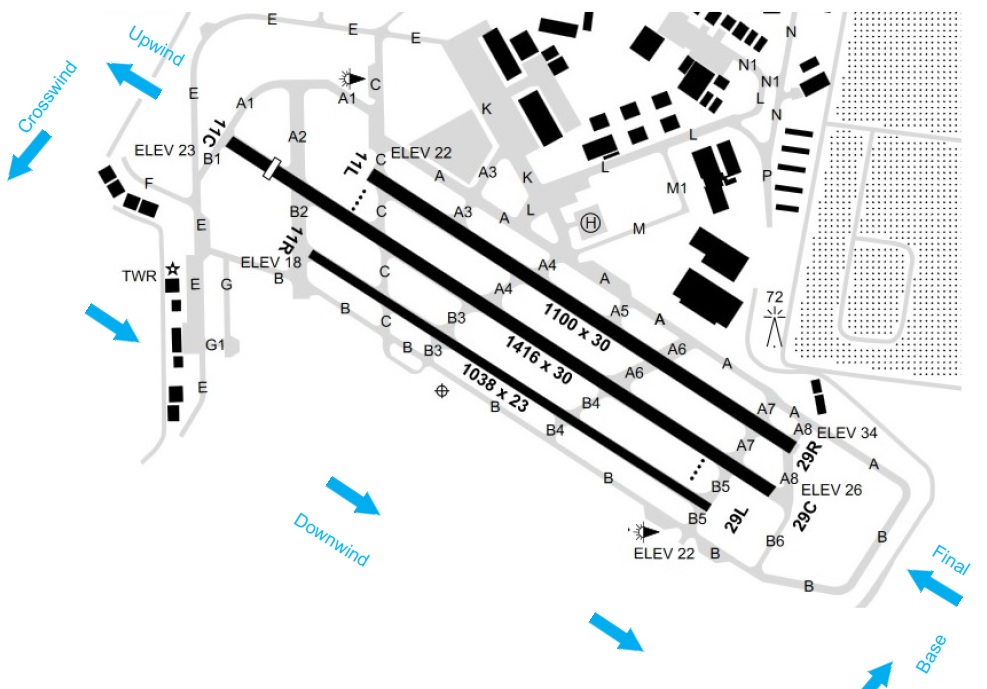| Occurrence Briefs are concise reports that detail the facts surrounding a transport safety occurrence, as received in the initial notification and any follow-up enquiries. They provide an opportunity to share safety messages in the absence of an investigation. |
What happened
On 13 June 2018 at 1957 Eastern Standard Time, a Diamond DA 40 was conducting solo night circuit training at Bankstown Airport, New South Wales. Bankstown is a class D metropolitan airport, with fixed wing and rotary pilots. The circuits were conducted on runway 29C, during tower hours with a left circuit direction. Meteorological conditions were reported as night (bright), visibility greater than 10 km with wind speeds a top of 5 kts.
The DA 40 was on upwind runway 29C and was instructed by air traffic control (ATC) to follow a Fairchild SA227 that was joining downwind. The pilot of the DA 40 sighted the SA227, which was positioned joining the circuit left downwind. The DA 40 pilot conducted a rate one turn[1] crosswind in front of the SA227. While conducting the turn, the pilot was focused on his instruments and lost visual contact with the SA227. ATC then instructed the DA 40 to conduct a left turn and re-join the circuit upwind.
The pilot continued his rate one turn and once established on the upwind leg for runway 29C, ATC instructed the pilot to follow a Piper PA 28, which had just become airborne off runway 29C. The pilot of the DA 40 reported sighting an aircraft ahead and below of his position and incorrectly assumed that was the PA 28, but it was another aircraft in the circuit.
As the PA 28 was climbing upwind, the crew sighted the DA 40 overhead and in close proximity. The pilot of the PA 28 pitched the aircraft’s nose down to increase separation and informed the tower of the DA 40’s position. ATC issued the DA 40 a safety alert and an immediate climb instruction to 1,500 ft.
The DA 40 had overtaken the PA 28 and had come into close proximity.
Both aircraft continued circuit training without further incident.
Figure 1: Bankstown runway layout with standard circuit arrows as guide only

Source: Airservices, annotated by ATSB
Safety message
Pilots and ATC have a dual responsibility in maintaining situational awareness of other traffic. When conducting flight in class D airspace, pilots must sight and maintain separation from other aircraft. If pilots lose situational awareness, ATC are available to pass traffic, however ATC must be notified immediately if aircraft crew cannot sight and maintain their own separation.
In this instance, the crew reported ATC had given them instructions to follow a Piper that had just become airborne, leading the crew to follow the incorrect aircraft. If any doubt exists as to the instruction given, whether it be a phrase used or the inability to comply with an instruction, crew are reminded to seek clarification from ATC immediately.
Pilots should always:
- sight and maintain separation from other aircraft
- comply with ATC instructions whilst ensuring separation is maintained from other aircraft
- notify ATC if a change in clearance is required
- immediately advise ATC if unable to comply with an instruction.
Below are some tips to remember when flying in class D airspace:
- Develop an easy, repeatable scanning technique. Be aware of your relative position and the movement of other traffic.
- Communicate clearly and listen for key words that indicate other aircraft’s position and intentions.
- Recognise the symptoms of losing situational awareness (distractions, fixation).
- Think ahead. Anticipate what will happen several minutes into the future.
For more information about flight tips at Bankstown, visit www.airservicesaustralia.com/publications/safety-publications/ and follow the links under the heading Runway Safety for Tips for flying at Bankstown and Operating in Class D airspace.
About this report
Decisions regarding whether to conduct an investigation, and the scope of an investigation, are based on many factors, including the level of safety benefit likely to be obtained from an investigation. For this occurrence, no investigation has been conducted and the ATSB did not verify the accuracy of the information. A brief description has been written using information supplied in the notification and any follow-up information in order to produce a short summary report, and allow for greater industry awareness of potential safety issues and possible safety actions.
__________


